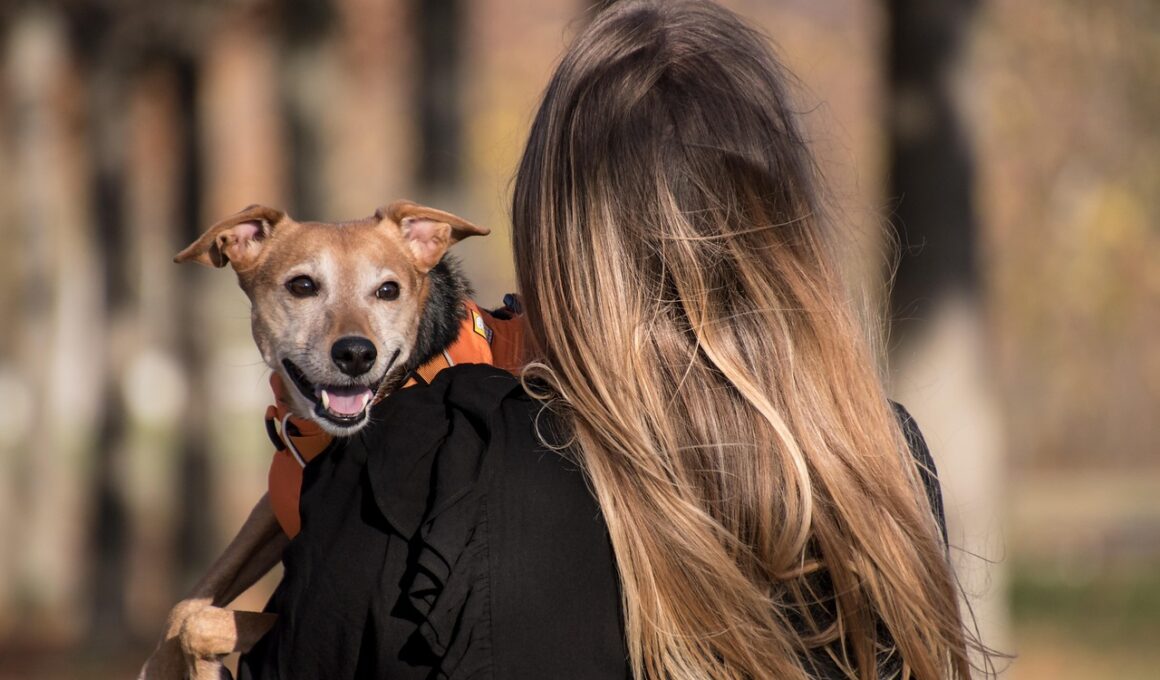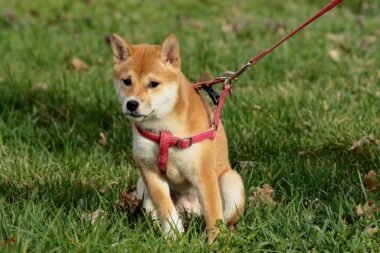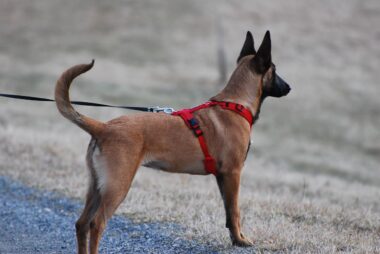Harness Training Tips for Puppies and New Dog Owners
Choosing the right harness is crucial for your puppy’s comfort and safety. Harnesses come in various styles, from standard designs to specialized options for pulling or support. It’s essential to consider the size and breed of your dog. A good fit ensures that your dog can’t escape easily and is comfortable during walks. Ideally, the harness should fit snugly without causing chafing. When selecting a harness, look for breathable materials to keep your pet cool. Additionally, certain harnesses attach to the front, which discourages pulling. Reading reviews and checking sizing guides can aid your choice. Gradually introduce the harness to your puppy; let them sniff it before putting it on. Reward them with treats to associate the harness with positive experiences. Proper harness training starts with short sessions inside the house. Use calm and inviting tones for positive reinforcement. Short walks can build their confidence, and always monitor their comfort throughout the process. Your goal is to foster a sense of ease with the harness. Remember, training may take time, so be patient and supportive as your puppy adjusts to their new accessory.
Key Training Techniques
Establishing a training routine is vital when acclimating your puppy to their harness. Begin by choosing a quiet, distraction-free area in your home to conduct your training. Start with familiarization, allowing your puppy to explore the harness at their own pace. For example, place it nearby during play sessions or feed them treats while they are near it. This approach creates a positive connection with the item. Once they seem comfortable, gently place the harness on them without securing it. Observe their body language—if they seem relaxed, gradually secure the harness while rewarding with treats and praise. Consistency is key; repeat these steps daily for best results. Pay attention to signs of discomfort, such as whining or refusal to move. If they show any negative reactions, take steps back and proceed more slowly. Keep training sessions brief to maintain their interest and focus. Aim for sessions lasting only five to ten minutes. Incorporating fun activities, like playtime or short walks, after successful harness fittings encourages better behavior. Remember, every puppy is different and may require a unique approach to harness training for success.
When your puppy has successfully adapted to wearing the harness, the next step is leash training. Leash training techniques are essential to ensure your dog walks alongside you, rather than pulling ahead. Start in your yard or a calm environment with the harness securely fastened. Attach a light leash to the various ring options on the harness to control their movements. Gently guide them close and use commands like “heel” or “let’s go”. Use treats to reward them for walking at your side, reinforcing the desired behavior. If they pull, stop walking and stand still until they return to your side. This teaches them that pulling leads to a halt, while walking calmly continues the adventure. Patience is necessary. Avoid yanking at the leash as this may harm your puppy’s neck and confuse them. Instead, employ positive reinforcement consistently. Gradually increase the distance and duration of your walks as they become accustomed. Continue practicing in diverse environments to generalize their training. Combining leash and harness training will create a cohesive experience that fosters a positive behavior pattern between you and your puppy.
Common Mistakes to Avoid
While training, be aware of frequent mistakes that can hinder your dog’s development. One common error is skipping the familiarization phase, which leads to anxious or resistant behavior. Allowing your puppy to associate the harness with fun experiences is critical. In addition, many owners inadvertently use an incorrect size or style harness. It’s crucial to measure your puppy’s girth to ensure an optimal fit. A harness that is too tight can cause discomfort, while one that is too loose may allow for escape. Avoid punishing your puppy during the training process, as this can induce fear and regression. Instead, use encouragement and patience. Another mistake is overwhelming your puppy with too much at once; patience is paramount in helping them adapt. Keep training sessions short and conclude on a positive note to increase engagement. Over time, your puppy will learn. Educating yourself on appropriate techniques and understanding puppy behavior can make the process smoother. Furthermore, attending obedience classes can provide additional support for you and your new pet.
Always monitor your puppy’s physical and emotional state during harness training. Signs of stress can manifest, including barking, whining, or trying to escape the harness. If you notice these, take a step back, and reassess your approach. Social interactions also play a critical role in your puppy’s adjustment. Introducing your puppy to other dogs with harnesses can provide them the social skills needed. Walking alongside experienced dogs allows for modeling of proper behaviors. Make sure to choose friendly dogs for these sessions and supervise interactions closely. Additionally, varying your walking routes helps your puppy gain confidence in various environments. Each new experience fosters adaptability, crucial for their overall development. Stay vigilant for signs of fatigue during training; don’t push your puppy beyond their limits. Learning to distinguish when to pause is equally important as training itself. Gradually increase the level of challenge and excitement in your walks as they concentrate better. Keep their favorite toys or treats on hand to reward their successes. As your bond strengthens, your puppy will begin to associate harnessed outings with joy and adventure.
Post-Training Tips and Maintenance
After your puppy has mastered the fundamentals of harness training, it’s essential to maintain and reinforce these behaviors consistently. Regular practice will ensure that the habits formed during training don’t fade over time. Incorporate harnessed walks into your daily routine. Enrich your walks with various activities to keep your puppy engaged. Look for opportunities to introduce new experiences, such as different parks or walking paths to avoid monotony. Keeping training sessions alive doesn’t solely apply to walks; engage your puppy in play and exercises that utilize the harness, like fetching or agility techniques. Additionally, always inspect the harness for wear and tear to guarantee it remains safe. Frequent checks help ensure that the harness still fits properly, as puppies grow quickly. If necessary, adjust the straps to maintain a secure fit. Maintain a clean harness by washing it according to manufacturer instructions. Cleanliness not only prolongs its life, but also keeps your puppy comfortable. Cultivate a routine that allows your puppy to feel safe and confident while wearing their harness during every outing.
Lastly, keeping an open line of communication with your veterinarian or a professional dog trainer can provide additional guidance throughout your training journey. They can help tailor specific advice to suit your puppy’s temperament and breed characteristics. If you encounter persistent issues with training, do not hesitate to reach out for support. There are numerous resources available, both online and in-person, including dog training classes. Consider enrolling in a puppy class that focuses on harness and leash training techniques. These workshops can be invaluable, providing hands-on guidance as your puppy develops their skills. Seek support from pet communities or forums where fellow dog owners share their experiences and solutions from their own training challenges. Connection with others can offer support and understanding during your training routine. Revisit successful techniques often while adapting new techniques slowly. Each step you take builds on fostering a secure and loving relationship with your puppy. Celebrate their successes, no matter how small, to encourage continued progress throughout your training journey together. Harness training can lead to enjoyable walks as your bond deepens over time.
In conclusion, harness training is not just about teaching your puppy how to wear a harness; it’s a valuable bonding experience that promotes trust and communication. Start with patience, understanding, and consistent practice to build a solid foundation. Gradually introduce the harness, use proper training techniques, and avoid common pitfalls to ensure a positive experience for you and your pup. Celebrate each achievement as your puppy learns and grows. With commitment and love, harness training can become an enjoyable and rewarding journey. As a dog owner, providing proper training reflects your dedication to your pet’s well-being. Remember, every dog is unique, and their training journey will differ. Stay flexible and adapt to your puppy’s needs and responses. Your efforts will pay off, resulting in a happy, well-adjusted companion. Continue to encourage positive behavior through reward-based training. A deep bond established through proper training fosters mutual respect and enjoyment in daily activities. Embrace the learning process and enjoy the immeasurable joy of your growing partnership. Investing time in these training strategies will lead to countless adventures and cherished memories with your beloved pet.





